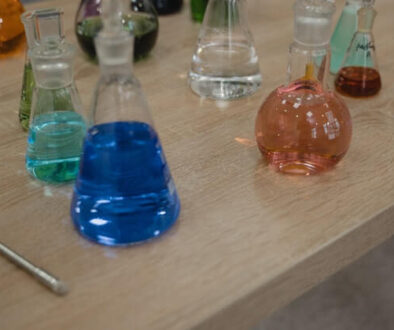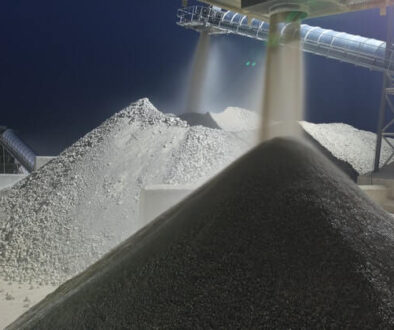Supplementary Cementitious Materials: Natural Pozzolans
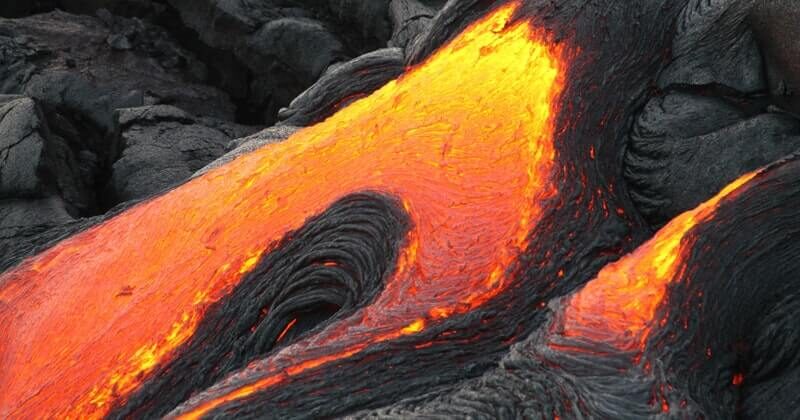
Last updated on March 23rd, 2022
Definition of supplementary cementitious materials
Supplementary cementitious materials are substances that affect the properties of hardened concrete by exhibiting either a pozzolanic or a hydraulic action.
Definition of pozzolanic materials and hydraulic actions
A pozzolanic material mainly consists of silica or a combination of silica and alumina. Usually such materials have no or little cementitious value by themselves. However, when ground to a finer size, they react with lime in the presence of moisture to form additional calcium-silicate-hydrate gel.
Whereas, a hydraulic material is a material that sets and hardens in the presence of moisture through hydration reactions.
What are natural pozzolans
Unlike artificial pozzolans, natural pozzolanic materials are a result of either the weathering and sedimentation process of soil, or the hot magma and rocks from volcanic eruptions. These materials are supplementary cementitious materials in their natural form. They mostly only require grinding and sieving to the desired size.
Types of natural pozzolans
Natural pozzolanic materials are classified into two groups, volcanic and sedimentary materials.

Natural pozzolans of a volcanic origin
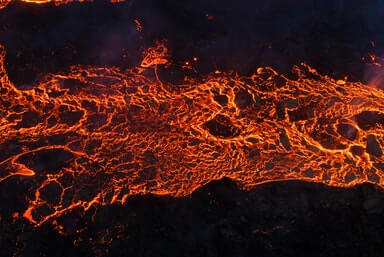 Basically, natural pozzolanic materials of a volcanic origin are formed of rocks from volcanic ash, and are mostly pyroclastic. Such materials mainly contain silica and alumina, in addition to a small amount of alkalis and iron. Moreover, these volcanic materials may alter their physical, chemical, morphological, and mineral composition due to weathering and geological transformation.
Basically, natural pozzolanic materials of a volcanic origin are formed of rocks from volcanic ash, and are mostly pyroclastic. Such materials mainly contain silica and alumina, in addition to a small amount of alkalis and iron. Moreover, these volcanic materials may alter their physical, chemical, morphological, and mineral composition due to weathering and geological transformation.
Thereby, volcanic materials are further classified into un-altered and altered pyroclastic materials.
Natural pozzolans of a volcanic origin: Un-altered pyroclastic materials
The un-altered pyroclastic materials are vitreous pumices, vitreous ashes, scoria, and tuffs.
Vitreous pumice
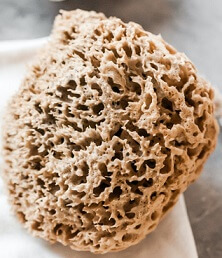
- Vitreous pumice is a highly-porous, light-weight, and light-colored vitreous rock which may or may not contain crystals. It is formed when super-heated and pressurized rocks are discharged during a volcanic eruption, and then naturally exposed to rapid cooling and depressurization, which in turn create bubbles. Hence, this process gives pumice pozzolan its distinctive foamy appearance. In addition, it has a porosity mostly more than 65%, and can float on water. Its typical chemical composition is as follows.
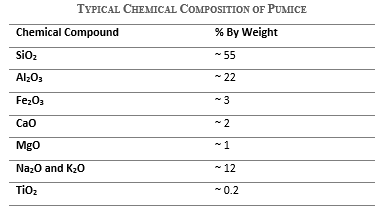
Scoria
- Scoria is a light-weight and vesicular igneous rock just like pumice. However it is darker in color, denser, and has a different chemical composition. Also, it contains mineral crystals, with basaltic magma as its source. The typical chemical composition of scoria is as follows.

Tuff
- Tuff is a rock formed when the materials blasted during a volcanic eruption fall back to earth and become consolidated or compacted into a rock. Thereby, tuffs include a broad range of materials, however having different chemical compositions. The main types of tuffs include welded, rhyolitic, trachyte, andesitic, basaltic, and ultramafic tuffs.
Other natural pozzolanic materials of a volcanic origin: Altered pyroclastic materials
The alteration of pyroclastic materials occurs mainly due to weathering and geological conditions. This alteration modifies their chemical composition into crystalline zeolites, such as zeolitised tuffs.
Natural pozzolans of a sedimentary origin
 Natural pozzolanic materials of a sedimentary origin are a result of either the weathering and erosion of rocks or the accumulation of micro-organisms or chemical compounds, or both.
Natural pozzolanic materials of a sedimentary origin are a result of either the weathering and erosion of rocks or the accumulation of micro-organisms or chemical compounds, or both.
Thereby, sedimentary natural materials are classified into detrital and chemical, in addition to a minor class of sediments of a mixed origin (such as Sacrofano Earth).
Natural pozzolans of a sedimentary origin: Detrital
Detrital sediments, such as naturally-burned clays, have a low pozzolanic activity despite their high silicate content. However, grinding such sediments to ultra-fine particles and applying thermal treatment can trigger their pozzolanic activity.
Natural pozzolanic materials of a sedimentary origin: Chemical
Chemical sediments, or bio-chemical sediments, are diatoms that mainly contain opaline, clay, hydrogen, and carbon.
- Diatomaceous earth is a bio-chemical sedimentary pozzolan, which owes a pozzolanic activity. However it is rarely found in a pure form. Such sediments usually contain undesired clays, thereby requiring calcination in order to increase their pozzolanic activity.
Conclusion
There are several types of natural pozzolans, however they can be mainly classified into two groups, volcanic and sedimentary. In addition, each group can be further classified into several sub-groups. These materials occur naturally and generally only require minor processing before their use in concrete.
Bibliography
- Chengula, D. H. (2017, May 29). Improving Cementitious Properties of Blended Pozzolan Based Materials for Construction of Low Cost Buildings in Mbeya Region, Tanzania. Structural Materials and Engineering Series, No.29.
- Depci, T., Efe, T., Tapan, M., Ozvan, A., Aclan, M., & Uner, T. (2011). Chemical characterization of Patnos scoria (Aǧri, Turkey) and its usability for production of blended cement. Physicochemical Problems of Mineral Processing, 303-315.
- Grasser, K. (1990). Building with Pumice. Friedr. Vieweg & Sohn.
- Science, G. (2021, April 27). Tuff.
- Snellings, R., Mertens, G., & Elsen, J. (2012). Supplementary Cementitious Materials. Reviews in Mineralogy & Geochemistry, 74, 211-27


